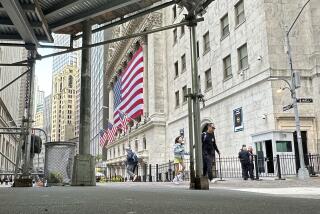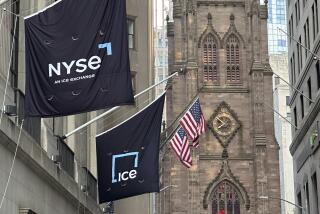Profit Taking Zaps Smaller Stocks : Market Overview
The NASDAQ market suffered its biggest one-day decline since last September, as growing uncertainty over the Clinton Administrationâs economic plan sparked widespread profit taking. Blue chips were off only slightly.
* Bond yields eased after Federal Reserve Chairman Greenspan hinted that the Fed could cut rates again, depending on the Administrationâs deficit-reduction program. Also, an auction of five-year Treasury notes saw better than expected demand.
Stocks
The marketâs long, steady climb since mid-October suddenly gave way to a rash of selling, as short-term traders rushed to bail out.
The NASDAQ composite index tumbled 9.26 points, or 1.3%, to 697.90, its biggest one-day percentage decline since it dropped 1.5% last Sept. 25.
The blue chip Dow industrials, though off about 20 points at their afternoon lows, closed with a 7.56-point loss at 3,291.39.
Traders said there was no particular trigger for the NASDAQ selloff, except that the marketâs four-month surge made it ripe for a fast decline. âEverybody just had the same idea at the same time--to sell,â said one trader at Hambrecht & Quist in San Francisco.
Marshall Acuff, portfolio strategist at Smith Barney, suggested that âpeopleâs confidence in (President) Clinton is beginning to slip a bit. People are getting jittery and nervous about whatâs going to be doneâ about the economy.
In the NASDAQ, losers swamped winners 1,319 to 781, compared to 1,175 to 707 on the New York Stock Exchange. Volume on the Big Board eased to 277.50 million shares from 314.11 million Tuesday.
The market failed to take strength from Fed Chairman Greenspanâs testimony before Congress. He said that although the economy was ânot out of the woods,â business activity has been âincreasing at a firmer pace.â
Among the market highlights:
* Technology stocks, the stars of the NASDAQ rally since fall, were the biggest losers. Intel lost 1 3/4 to 112 5/8, Microsoft dropped 1 3/4 to 86 1/4, Dell Computer slumped 1 5/8 to 47 3/4, and Oracle slid 1 7/8 to 33 1/4.
El Monte-based electronics distributor Marshall Industries plunged 3 7/8 to 35 5/8 after projecting lower quarterly earnings.
* In biotech, Synergen lost 1 to 55 3/4 after trading as low as 53. The company said a hoaxster had called a medical-investment newsletter with false, negative information about final trial results of Synergenâs key new drug, Antril.
* In trading typical of many smaller NASDAQ issues, Pacific Physicians, a Redlands-based health care management firm, plunged 4 1/2 to 20, even though there was no news about the firm. The company said it could only assume the drop was profit taking.
* Among bigger issues, sellers targeted Circus Circus, which fell 3 to 53 5/8; Nike, off 1 3/4 to 80 7/8, and Merrill Lynch, down 2 to 67 1/4.
*Duracell tumbled 1 3/8 to 33 1/8, while SLM Intl. gained 1 1/4 to 24 3/4. SLM said it has created a recharger for alkaline batteries. Duracell said recharging is âunsafe.â
* On the plus side, some bank stocks gained on hopes for still-lower interest rates. Chemical Banking jumped 1 1/2 to 41 3/4, Citicorp added 3/4 to 26 3/8, and Wells Fargo was up 7/8 to 99 5/8.
Overseas, Frankfurtâs DAX average finished at 1,562.32, off 13.84 points, while Londonâs Financial Times 100-share index slipped 3.2 points to 2,832.5.
In Tokyo, the Nikkei average added 17.05 points to 16,509.68.
In Mexico City, the Bolsa index lost 38.61 points, or 2.2%, to 1,740.69 amid foreign selling.
Credit
Buyers returned to bonds after Tuesdayâs selloff, as Fed Chairman Greenspan said the Fed will maintain an anti-inflationary monetary policy, but one that supports âan extension of the recent more hopeful signs of solid growth.â
Many traders took that as a hint that the Fed could ease credit again, especially if it sees real progress in the Clinton Administrationâs attempt to cut the federal budget deficit.
The yield on the 30-year Treasury bond slipped to 7.24% from Tuesdayâs 7.25%. Shorter-term rates declined more substantially.
It helped that the Treasuryâs auction of $11.5 billion in five-year notes was well-received, after a poor showing for two-year maturities at an auction Tuesday. The median yield on the five-year notes was 5.63%.
Other Markets
The dollar rose in listless trading. The gains were most pronounced against the British pound, one day after Britain cut interest rates to 15-year lows.
At the close in New York, it took $1.511 to buy one pound, down from Tuesdayâs $1.538.
The dollar also rose to 124.10 Japanese yen, up from 123.55 on Tuesday, and to 1.587 German marks, up from 1.577.
Meanwhile, oil edged higher on the New York Merc. Near-term crude gained 2 cents to $19.66 a barrel. On the Comex, near-term gold lost $1.20 to $329.90 an ounce. Silver fell 2 cents to $3.68.
Market Roundup, D6
More to Read
Inside the business of entertainment
The Wide Shot brings you news, analysis and insights on everything from streaming wars to production â and what it all means for the future.
You may occasionally receive promotional content from the Los Angeles Times.










